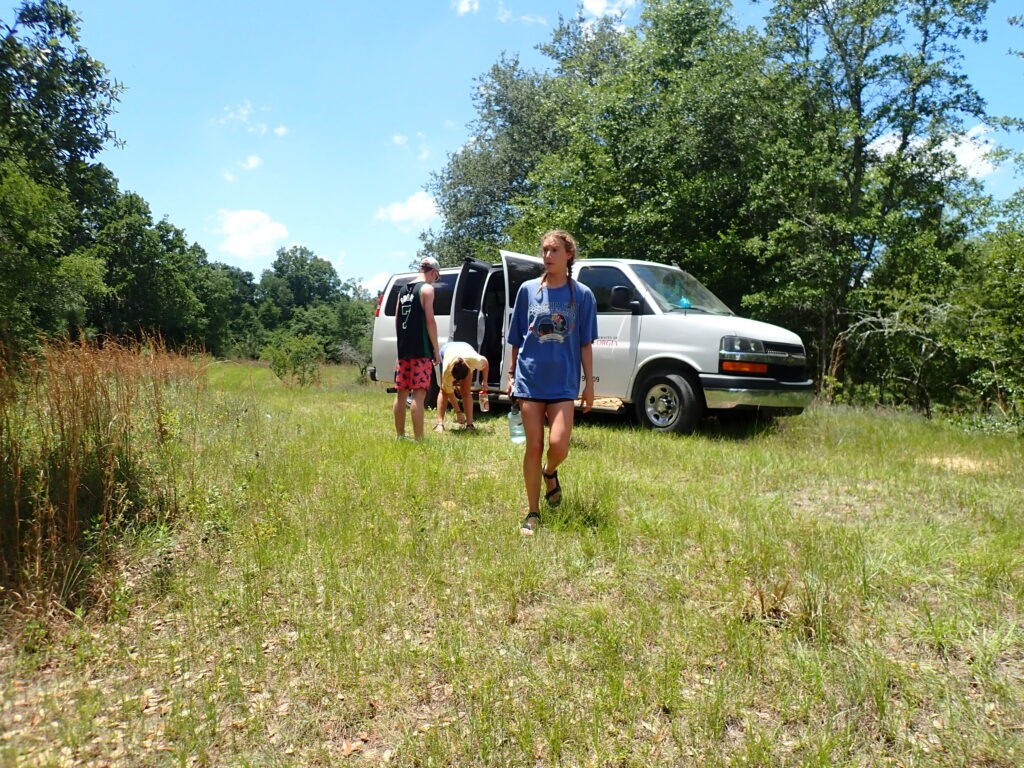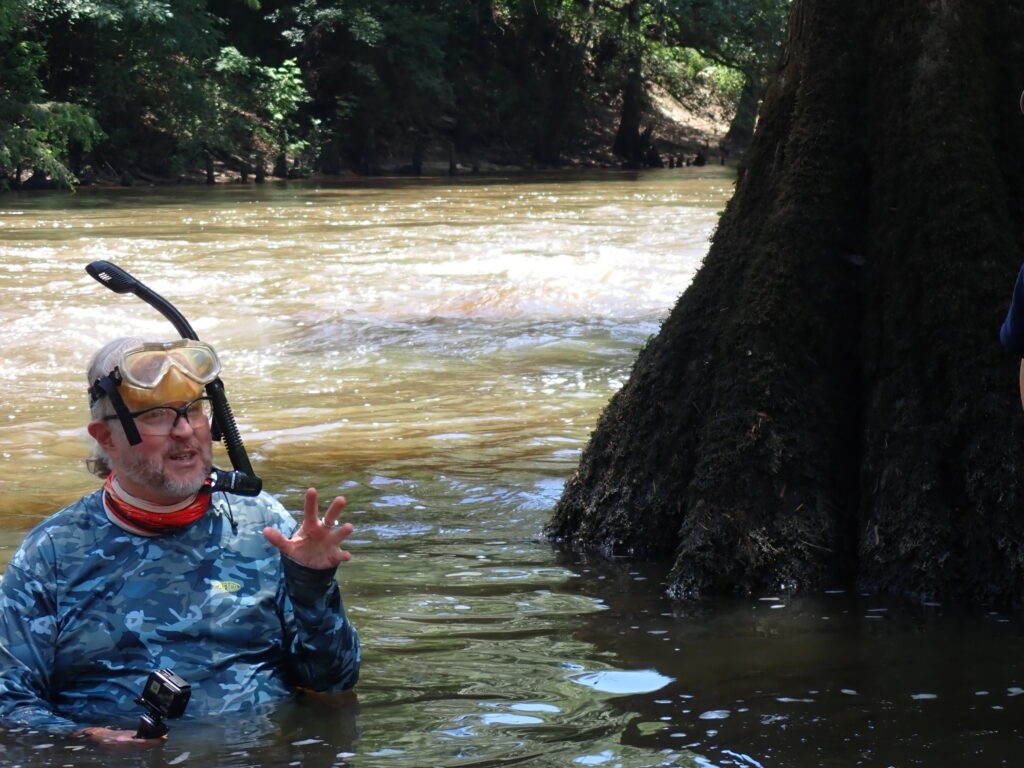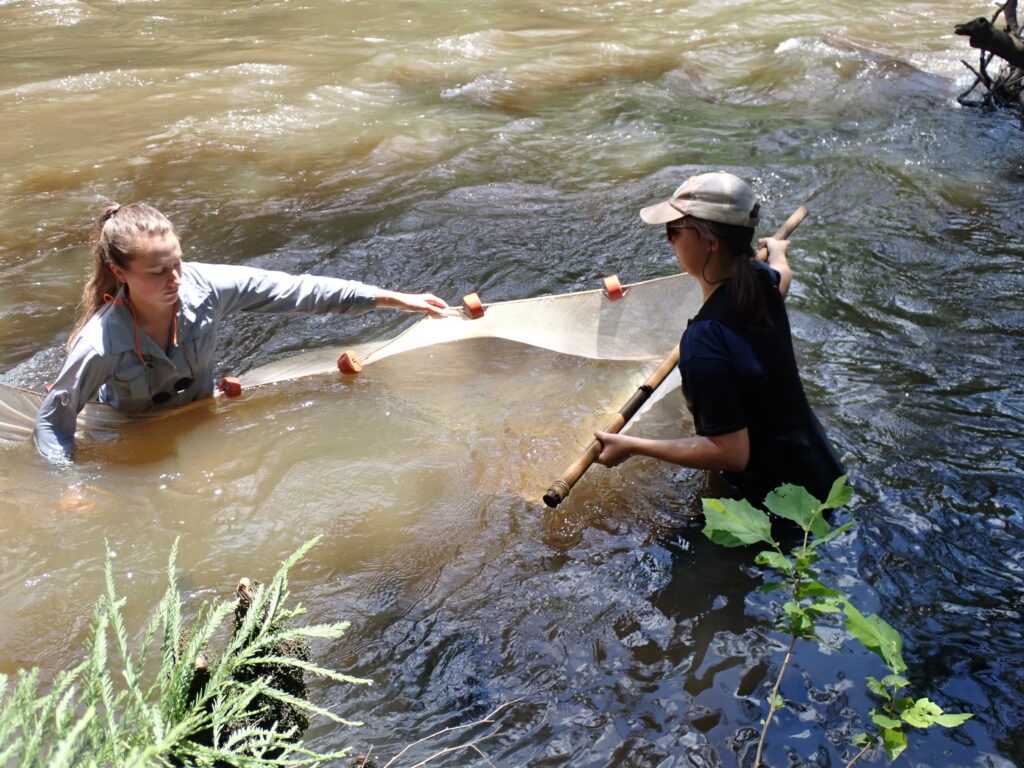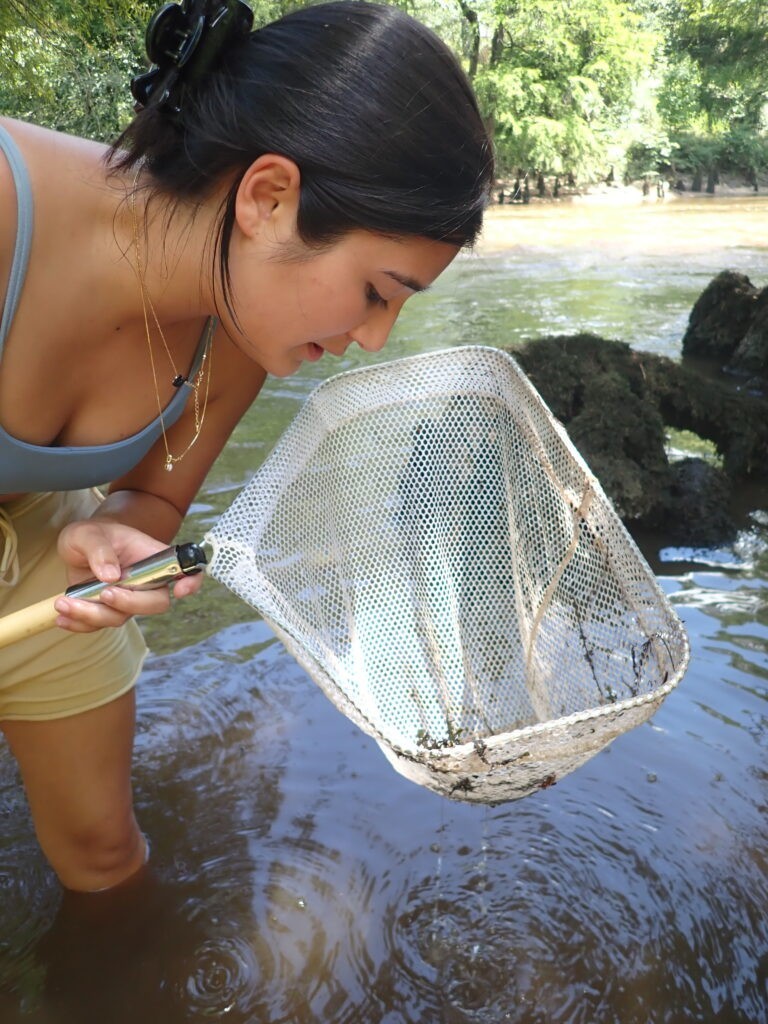Across three state and three rivers: An experiential learning journey
Science doesn’t—and shouldn’t—happen in a vacuum. Amanda Rugenski, lecturer and undergraduate coordinator at the University of Georgia Odum School of Ecology, gets that.
“To be able to listen to people is really important, not just to the scientists, not just to the water managers, but also to the communities that are present in these areas,” she said.
She hopes the question of who needs to have a seat at the table is something students take away from the Maymester study away course she led (ECOL 3300, Field Program in Ecological Problem Solving), from May 21 to June 4, 2022, with the assistance of Odum graduate students Kristen Zemaitis and Jeffrey Beauvais.
Rugenski’s class of 19 had ample opportunity to practice listening as they attended presentations and hands-on workshops throughout swaths of the Apalachicola-Chattahoochee-Flint (ACF) River Basin, learning to view environmental issues through a social-ecological lens.
Ecological Problem Solving is an experiential learning course offered annually for Ecology A.B. students, and it’s an anchor course for the Sustainability Certificate. The class is meant to give students a whirlwind introduction to problem solving at the intersection of science, society, and policy. The course is built around one such issue—the tri-state “Water Wars”—and the efforts of a regional organization, the ACF Stakeholders, Inc., to provide solutions through consensus.
For several decades, Georgia, Alabama, and Florida have disputed water allocation in the ACF Basin. Georgia needs water to support both agriculture in the southern part of the state and the continued growth of Atlanta in the north. Alabama requires water for power, drinking supply, and fisheries, and Florida needs enough water to reach the coast to prevent saltwater intrusion and to sustain its seafood industry.
In response, the ACF Stakeholders—composed of a range of people including civic leaders, farmers, fishermen and researchers across sectors and state lines—aims to foster informed, cooperative and equitable water sharing.
The group’s goals dovetail perfectly with those of the class. To Rugenski, the organization is illustrative of a critical point.
“Sometimes when we think of problem solving, people don’t think of humans as being a part of the solution, and others may not think of the environment and ecosystem as being part of the solution. I want students to see how interconnected these all are, to solve these complex problems,” said Rugenski.
Out of the classroom and into the creek: Field experience at the Jones Center
The group experienced the ACF basin from its headwaters to the Gulf Coast, traveling a roughly 1,000-mile loop and visiting as many of the ACF stakeholders as possible along the way to learn first-hand about their perspectives and priorities. Their travels included stops to sample fish in the Chestatee River in North Georgia, a visit from an attorney with the Southern Environmental Law Center, a tour of the AgLanta Urban Food Forest at Browns Mill, and a meeting with the West Atlanta Watershed Association.
The group swept through Florida, with highlights including a stop at the Apalachicola National Estuarine Research Reserve, a visit from Dr. Brooke, who presented on the Apalachicola Bay System Initiative and a tour of the bay by boat to learn about restoration projects along Highway 98.
By Memorial Day, the class had wound its way back to southern Georgia, to the Jones Center at Ichauway.
Aquatic biologist Steve Golladay welcomed them to the reserve, or what he calls “30,000 acres of green in a sea of agriculture,” and presented background about the research center and the scope of natural resource management in Georgia.
The center’s threefold focus is on water—the unique hydrology of the mostly free flowing Flint River and its tributary, Ichawaynochaway Creek; woods—preserving its longleaf pine ecosystem; and wildlife—protecting the roughly 1,200 species present on the reserve, partially supported by its isolated wetlands.
On paper, Georgia is a freshwater-rich area, Golladay shared, with an average of about 50 inches of rainwater a year. That’s well above the national average. And the Flint—15 miles of which wends through Ichauway—is partially fed by the rapidly recharging Floridan aquifer, not just runoff and seepage. That makes it an especially reliable source of freshwater.
The challenge is that no single year gets the average amount of rainfall. Some years see 70 inches and others see 30—sometimes several years in a row, leading to periods of stress on water systems and periods of abundance. Sensibly bridging the gap between the two is a major water management goal.
The Jones Center supports some of the most robust research on longleaf pine management in the country. Of the 30,000 acres on the ecological reserve, longleaf pine forest makes up about 18,000.
A habitat type that once spanned between 60 to 90 million acres of land in the southeastern United States prior to European colonization, longleaf ecosystems are reduced to about four and a half million acres today.
Ichauway’s second-growth pine is now mature, at 80 to 100 years old. It’s the perfect tree cover for Georgia’s on-again, off-again water supply: longleaf pine stops pumping water in drought years. It offers the benefits of forestation without straining water systems in times of water scarcity.
A large part of the center’s mission is providing access to its findings and the physical space itself.

That’s why, when his presentation was over, Golladay took the students to Ichawaynochaway Creek to go “mussel hugging,” a term he uses to encompass both the process of finding and identifying mussels and the unbridled enthusiasm with which he feels that task should be undertaken.

Graduate student Jamie Rogers and research associate Caitlin Sweeney, with the help of student volunteers, set up a kick net and searched for critters. The water was clouded, but the murky flow was actually the result of staining from swamps up river, Golladay explained. It’s normally quite clear, with visibility sometimes reaching 15 feet.

Though no mussels were found, students discovered minnows, small fish, insects and several crayfish. It’s the kind of field experience and tactile learning that Golladay says the center is all about.
“I think one of the things that we offer at Ichauway is a real field experience. We’re all field-oriented, and so it gives people a chance to come and stay here, to see what we do out in the world. Especially now, given that we’re coming out of two years of virtual learning, the role of places like Ichawauy has become extremely important,” Golladay said.

And students were conscious of that. For class member Alanna Deveter, the interactive nature of the course wasn’t just a perk—it was integral to her learning experience.
“I definitely prefer this type of learning environment to just sitting in a classroom,” she shared. “I have a pretty busy brain. So hands-on works for me. It’s an actual experience where I get to have my own perspective.”
And with each stop, students’ perspectives became more and more informed.
This kind of experiential learning is available to all A.B Ecology majors and students pursuing the Sustainability Certificate. Current and prospective students can learn more here.
Read about the students’ stop at Albany State’s Water Policy Center, UGA’s Stripling Center and the Flint RiverQuarium, here. Catch the final installment in the series, about the class’s float on the Flint, here.

